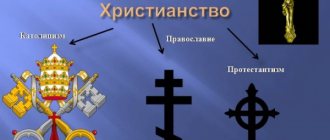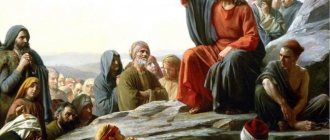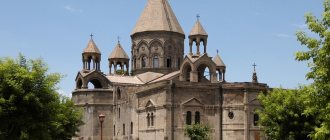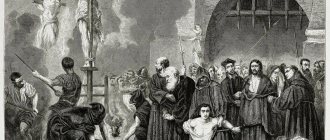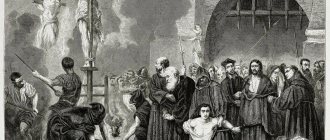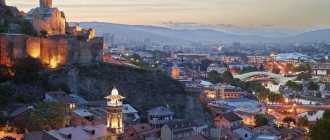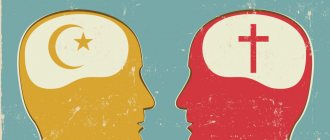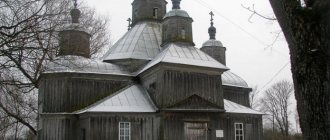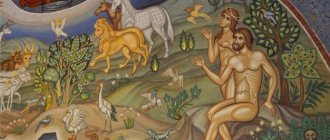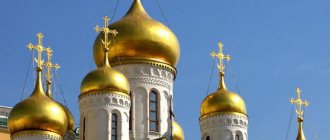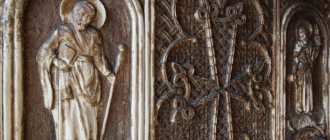The emergence of Christianity
Definition 1
Christianity is one of the world’s so-called “Abrahamic” religions. There are three branches of Christianity: Orthodoxy, Catholicism, and Protestantism. The basis of Christian teaching is faith in Jesus Christ, perceived as the God-man, the Savior, the incarnation of the second hypostasis of the triune Godhead, that is, the Trinity.
Christianity was formed in the 1st century AD in Palestine, the eastern province of the Roman Empire, as a consequence of the messianic preaching of Judaism, with which Christianity soon began to conflict (this happened after Christians were excluded from synagogue life in 70 AD).
The emergence and spread of Christianity is associated with the struggle of the oppressed sections of the population of the Roman Empire, which included subjugated ethnic groups and slaves. Powerlessness against the might of the empire created despair and apathy. Salvation was seen only in the hope of something better that would happen one day. They began to look for such hope in religion. Great Rome paid attention to the new religion and sought to use it to its advantage. The centralization of power in Rome was in harmony with the idea of one God. This is due to the collapse of the slave system, which required new ideological ways of influencing the authorities on the masses of people subordinate to them.
Are you an expert in this subject area? We invite you to become the author of the Directory Working Conditions
The main ideological sources of Christianity, which became the basis of the religion:
- Judaism, from which Christianity took the recognition of the Old Testament, its content, the image of Christ, the idea of the Messiah;
- the ideology of the Qumran community, developing the doctrine of the second coming of the Messiah;
- the religion of the eastern peoples of the Roman Empire, from which many mythical images and stories were taken that made Christianity a multi-ethnic religion;
- religious and philosophical teachings of Philo and Seneca, who introduced into Christianity ideas concerning innate sinfulness, the need to save the soul as the goal of life, love for enemies and submission to fate.
Orthodox doctrine and cult
Orthodoxy as a variety of Christianity.
The political and cultural division of the Roman Empire already in the 3rd - 4th centuries led to the separation of the Eastern and Western churches. In the east of the Roman Empire, four autocephalous (independent) churches were formed: Constantinople, Alexandria, Antioch, and Jerusalem.
Soon the Cypriot and then the Georgian Orthodox churches separated from Antioch. In the middle of the fifth century, not recognizing the decision of the Council of Chalcedon, the Armenian Gregorian Church became isolated. The biggest blow to the unity of Christianity was dealt on June 16, 1054 an anathema against each other , that is, they subjected each other to a church curse.
In fact, the split of Christianity into two main directions - Orthodoxy and Catholicism - occurred much earlier, after the collapse of the Roman Empire at the beginning of the 5th century. to East and West. Orthodoxy was formed in the Eastern part of the Roman Empire, in Byzantium. Catholicism - in the Western part of the Roman Empire. Byzantium at that time was a strong centralized state. The Emperor of Byzantium considered himself the head of the entire Roman Empire. Constantinople was declared the capital of the Roman Empire. In the VI century. head of the Byzantine Church, the Patriarch of Constantinople, after Byzantium liberated Rome from the barbarians, began to call himself the ecumenical patriarch, that is, the head of both the eastern and western churches. The rivalry between the head of the Roman Catholic Church, the Pope, and the Patriarch of Constantinople for power over Christians continued for many centuries.
Currently, there are 15 autocephalous (independent) Orthodox churches: Constantinople, Alexandria, Antioch, Jerusalem, Russian, Georgian, Serbian, Bulgarian, Cypriot, Hellenic (Greek), Romanian, Albanian, Polish, Czechoslovak, American.
All Orthodox churches have common doctrine, cult and canonical activities. The basis of Orthodox dogma is the Nicene-Constantinopolitan Creed, adopted at the first two Ecumenical Councils (325 - Nicaea and 381 - Constantinople (Constantinople in ancient Russia was called Constantinople, hence the name Nicene-Constantinople Creed). This creed was approved in the form of 12 members (paragraphs), containing dogmatic formulations of the main provisions of the doctrine of God as the creator, about his relationship to the world and man, about the trinity of God, the incarnation, atonement, the resurrection from the dead, the saving role of the church, etc. The Orthodox calls himself Orthodox because he proclaims his duty to preserve intact “the deposit of faith entrusted to the original church, without adding or subtracting anything to the dogmatic heritage of the universal church.” In reality, this means recognizing as true only those provisions of the doctrine that were first approved seven Ecumenical Councils.
The subsequent five councils introduced certain clarifications and clarifications into the dogmatic formulations of the Nicene-Constantinopolitan Creed. At the Third of Ephesus (431), six rules were approved to protect the dogma of the Incarnation in connection with the attempt of supporters of the Patriarch of Constantinople Nestor to weaken the divine essence of Jesus Christ. Woman, the Nestorians argued, gave birth to man, not God. And only by the inspiration of the Holy Spirit did divinity move into him. At the Fourth of Chalcedon (451), the main attention was paid to substantiating the dogma of atonement and incarnation. The fifth, sixth and seventh Ecumenical Councils were devoted to resolving disputes about the form in which Jesus Christ should be depicted, and whether it was even possible to use images of sacred persons and worship of these images in churches. The Fifth Ecumenical - Second Council of Constantinople (553) obliged to depict the Son of God in human form, and not in the form of a lamb. The Sixth Ecumenical Council (Elvira) established the rule that there should be no objects of veneration or worship on the walls of churches. The Seventh Ecumenical - the second Nicene (787) approved the rule according to which the depiction of sacred persons and events and the worship of them were considered necessary.
So, as a result of the first seven Ecumenical Councils, the Orthodox doctrine was formed. This creed is reproduced daily by Christian believers in the form of a prayer - “I Believe”, as a sign of recognition of the main provisions of the creed. Briefly, the content of the Orthodox doctrine can be presented as follows:
Orthodox believe in one God, who created the whole world, including man. This God, according to Orthodox concepts, represents the identity of three equal persons: God the Father, God the Son and God the Holy Spirit; into the original sin, which was committed by the first people Adam and Eve; at the second coming of Jesus Christ - God the Son, who became man (that is, took on human form, being born through the virgin birth from the Virgin Mary) and voluntarily offered himself as a sacrifice for the sins of mankind (was crucified on the cross and was resurrected on the third day, and After 40 days he ascended into heaven) and will come again a second time in power and glory to judge the living and the dead and establish his eternal kingdom on earth as in heaven, in which the righteous will bliss and sinners will be tormented forever. Orthodox believe in the immortality of the soul, in the existence of hell and heaven, where the souls of the dead reside until the Last Judgment. According to the Orthodox faith, salvation can only be achieved within the framework of the church, which is the “mystical body of Jesus Christ,” a mediator between God and man.
In Orthodoxy, like any other religion, a system of cult actions is closely connected with dogmatic dogma. The basis of these religious actions are seven main rites - sacraments. These cultic actions are called sacraments by theologians because in them “under a visible image the invisible divine grace is communicated to the believers.” The Orthodox recognize seven sacraments: baptism, communion (Eucharist), repentance (confession), confirmation, marriage, unction (unction), priesthood.
In addition to performing the sacraments, the Orthodox cult system includes prayers, veneration of the cross, icons, relics, relics and saints. Prayers are a believer’s appeal to God or saints with his requests, complaints, gratitude, etc. Prayers can be mental or verbal, expressed in an appropriate verbal address to God or a saint. Prayers can be individual and collective. An example of congregational prayer is litany. During collective prayer, great importance is attached to certain ritual actions: kneeling, raising hands, closing eyes, etc.
Worship of the cross is one of the most important elements of the Orthodox cult. The cross is a symbol of the Christian faith. It is crowned with Orthodox churches, the robes of clergy, it is worn on the body by believers, and during prayers and services, believers and clergy make the sign of the cross (cross themselves). According to Orthodox teaching, the cross as a symbol was adopted by the Christian Church in memory of the martyrdom of Jesus Christ, who, as is known from the Bible, was crucified on the cross and thereby sanctified it with his blood. The cross is credited with magical saving power. The shape of the cross can be different: four, six (to depict the inscription nailed above the head of Christ) and eight-pointed (with the addition of a beam for the legs).
The cult of icons - painted or relief images of God the Father, God the Son, God the Holy Spirit, the Trinity, the Mother of God, saints, evangelists, etc. is widespread in Orthodoxy. It is believed that through these images a believer can come into contact with the characters depicted on them and turn to them with prayers. Some icons enjoy a special object of veneration. They are recognized as having a special miraculous power, because some miraculous events are associated with these icons. An example of such an icon is the icon of the Kazan Mother of God.
Orthodox believers also venerate holy relics. Relics, according to Orthodox teaching, are the remains of the dead, who by God’s will remained incorruptible and possessing the gift of miracles. Unlike Byzantine Orthodoxy, in which relics are understood only as incorruptible bodies, in Russian Orthodoxy the idea of relics as incorruptible bodies, as well as parts of the body, removed by the power of God from the universal law of corruption prevailed.
The cult of saints is closely related to the cult of relics. According to the teachings of the church, saints are persons who led a pious life, performed “exploits” for the glory of God, and after death were marked by the supreme gift of miracles, the ability to influence the destinies of people. Orthodox Christians believe that saints are mediators between God and people, heavenly patrons of those living on earth, and turn to them with requests for earthly matters. Canonization is carried out on the basis of the act of canonization. In the first centuries of Christianity, canonization occurred spontaneously, perpetuating the memory of martyrs, hermits, and confessors. Later, certain rules were developed, one of which is the acquisition of the relics of a given saint. Currently, issues of canonization in the Russian Orthodox Church are dealt with by a special commission, whose proposals are considered by the Holy Synod and decisions of Local Councils are made. The Orthodox canon contains a strict hierarchy of saints: angels, prophets, apostles, saints, martyrs, saints, and righteous people.
Holidays and fasts occupy an important place in the Orthodox cult In church calendars, every day is associated with the name of Jesus Christ, the Mother of God, saints, miraculous icons, and the cross. At the head of the holiday circle of the Russian Orthodox Church is Easter.
Easter is the most revered general Christian holiday in Orthodoxy, established in memory of the resurrection of the son of God Jesus Christ crucified on the cross. Since the idea of resurrection is central to Christianity, the holiday dedicated to this event is given a central place. Orthodox theologians call it the “feast of feasts” and the triumph of celebrations. This holiday is celebrated on the first Sunday after the spring equinox and full moon. To calculate the day of Easter celebration, special tables are compiled - Easter .
Following Easter in importance are the so-called twelve holidays - the Nativity of Christ, the Baptism of the Lord, the Presentation, the Annunciation, the Transfiguration, the Nativity of the Virgin Mary, the Dormition of the Virgin Mary, the Exaltation of the Cross, the Entry of the Lord into Jerusalem or Palm Sunday, the Ascension and Trinity.
The twelve feasts are followed by five feasts, called great: the circumcision of the Lord, the Nativity of John the Baptist, the feast of Saints John and Paul, the beheading of John the Baptist, the protection of the Most Holy Theotokos.
The remaining holidays are called patronal holidays. These are local holidays associated with thrones - a holy place in the temple, which is dedicated to one or another saint. In the Russian Orthodox Church, “Nikolin’s Day”, “Ilya’s Day”, the day of the “Kazan Mother of God” and others are widely spread.
The Russian Orthodox Church (ROC) is without a doubt the largest Orthodox organization in our country. But along with it, outside the framework of the Russian Orthodox Church, for a long time in the Russian Empire, in the USSR and in modern Russia, other Orthodox organizations historically associated with the Russian Orthodox Church operated and continue to operate. The emergence of these organizations is associated with deep conflicts that arose from time to time in Russian society and captured the Russian Orthodox Church in their orbit.
The Russian Orthodox Church experienced the most significant shock in the middle of the 17th century, when a schism occurred. In religious literature, a schism is understood as a religious and social movement that led to the separation of the Old Believers from the Russian Orthodox Church.
The reason for the schism was the reform carried out on the initiative of Tsar Alexei Mikhailovich and Patriarch Nikon , aimed at correcting liturgical books according to Greek models and establishing uniformity in church services. The rationale behind this reform was as follows: a theological school was opened in Kyiv where one could learn ancient languages and grammar. Several students of this school were allowed to publish liturgical books at the Moscow Printing Yard, the only state printing house at that time. Comparing the handwritten and printed texts of published books in accordance with their official duties, they found that the printed editions were unsatisfactory, and the handwritten ones were full of discrepancies. The only way to establish a correct and uniform text was to turn to the Greek originals. They wrote out the Greeks and the Greek originals, began to compare them and, in addition to translation errors and copyist's errors, noticed in the Russian books original Russian inserts that corresponded to the national ritual characteristics. These insertions were to be removed from the revised text.
Nikon, recently elected to the position of patriarch, personally went to the patriarchal library and, as best he could, compared the books of the Moscow press there with ancient Greek manuscripts and became convinced of the existence of disagreements. He convened a Local Council; at this council, the necessary changes were made to the liturgical books and liturgical practice. These changes were insignificant for Orthodox doctrine and cult, that is, they did not affect the foundations of Orthodoxy, its dogma and sacraments, but concerned some grammatical and cult innovations. Instead of “Jesus” they began to write “Jesus”, instead of “singers” - “singers”, etc. The two-finger sign of the cross was replaced with a three-finger one, along with the eight-pointed cross, the four-pointed one was recognized. Prostrations to the ground have been replaced by bows from the waist, and the direction of movement during the service has been changed (“posolon”).
However, these changes have had enormous consequences. The entire Russian society split into adherents of the old and new faiths. This split had its own ideological and socio-political motives. Supporters of the “old faith”, “old rite” defended the idea of the originality of Russian Orthodoxy, its superiority over other Orthodox churches, including over its ancestor - the Constantinople, which, in their opinion, having concluded the Union of Florence with the Roman Catholic Church in 1481, fell into heresy. From the point of view of the Old Believers, Greek liturgical books are not models for the Russian Church. You never know what is written there. We have our own true, Russian Orthodox faith. And they rose up to fight against innovations.
Opponents of the reform were subjected to a church curse - anathema at the Local Council of 1666-1667 . From that time on they were subjected to severe repression. Fleeing from persecution, the defenders of the “old faith” fled to the remote places of the North, the Volga region, Siberia, and the south of Russia. As a sign of protest, they burned themselves alive. Between 1675 and 1695, 37 collective self-immolations were recorded, during which at least 20 thousand people died. The ideological leader of the Old Believers was Archpriest Avvakum , who also carried out an act of collective self-immolation in the log house of a house under construction.
Brutal repression by the tsarist government, as a result of which thousands of supporters of the Old Believers were executed, tens of thousands were tortured, imprisoned and exiled, did not shake the most ardent adherents in their beliefs. They declared the existing authorities to be the proteges of the Antichrist and refused all communication with the worldly (in food, drink, prayer, etc.). They base their liturgical practice on the old liturgical books. They also preserved their chronology from pre-Petrine times.
Already at the end of the 17th century, the Old Believers split into two main directions: priests and bespopovtsev. The former recognized the need for priests during services and rituals, the latter denied any possibility of the existence of a “true clergy,” since, in their opinion, it was exterminated by the Antichrist.
The Popovtsy and non-Popovtsy were divided into various rumors: the fugitive-priest, Pomeranian, Fedoseevsky, Filippovsky, wanderer, Spasovsky, Belokrinitsky hierarchy, etc. These rumors, in turn, were divided into numerous agreements.
In 1971, at the Local Council of the Russian Orthodox Church, the anathema of the Old Believers was lifted, and thus the canonical prerequisites were created for rapprochement and unification with the Russian Orthodox Church. But such a process did not take place. It all ended with declarations. Currently, there are a number of independent Old Believer churches operating in Russia. Popovtsy: Russian Orthodox Old Believer Church (metropolitanate) headed by the Metropolitan of Moscow and All Russia; Russian Ancient Orthodox Church (archdiocese) headed by the Archbishop of Novozybsk, Moscow and All Russia. Bespopovtsy: Pomorsky, Fedoseevsky, Filippovsky, Spassky, Chasvensky consent.
Another important event that shook the foundations of the Russian Orthodox Church was the Great October Socialist Revolution. To some extent, it contributed to the mass departure of believers from the church and led it to an internal split. In 1922, a powerful ideological, theoretical, organizational movement— renovationism—was formed in the Russian Orthodox Church.
Renovationism was a heterogeneous movement, including three main groups: the so-called “Living Church” led by Archbishop Antonin (Granovsky), “Church Revival” (headed by V.D. Krasnitsky) and “Union of Communities of the Ancient Apostolic Church” (led by Archpriest A.I. Vvedensky). The Renovationists repeatedly made attempts to consolidate their movement and create a single organization. The largest of these attempts was the convening in May 1923 of the Second All-Russian Local Council of the Orthodox Church, which adopted a number of important documents aimed at modernizing doctrine and cult and reconciling the church with Soviet power.
The ideologists of the renovationist movement put forward a broad program of reforms, which included a revision of all aspects of church life: dogmas, ethics, liturgy, canon law, etc. The ultimate goal of these reforms was to eliminate all those layers in Orthodox dogma and church practice that caused protection by the clergy of the interests of the exploiting classes, and the creation of an ideological basis for the transition to a position of defending the interests of workers and peasants. One of the most important features of the renovation movement of the 20s was a clear social reorientation of Orthodoxy. From the very beginning, the leaders of the renovation movement welcomed the Great October Socialist Revolution and worked closely with representatives of the Soviet government in solving many specific problems of the relationship between church and state. They condemned the anti-Soviet actions of the top of the official Russian Orthodox Church, led by Patriarch Tikhon. “Church people started a stupid and criminal struggle against Soviet power,” wrote Archpriest Vvedensky. - We stop this fight. We openly tell everyone that you cannot go against the power of the working people. Everyone needs to work so that the untruth of external life is destroyed, so that there is no rich and poor, so that people are brothers.” In accordance with their concept of the “holy church” and the “churchliness” deforming it, the Renovationists also welcomed the Decree on the separation of church from state and school from church as an act destroying the “golden chains”. “For religious consciousness, the Decree on the separation of church and state is the fulfillment of the best, most cherished aspirations. The Church is the Church, the Church of Christ and nothing more,” said A. I. Vvedensky.
The revolutionary-democratic activities of the renovation movement were received with great sympathy by Orthodox believers, and at first there was significant support for this movement. In 1922, about a third of Orthodox parishes and 37 of the 73 ruling bishops joined the Renovationists. Of course, not everyone did this sincerely, for ideological reasons. Many of the hierarchs were most likely guided by opportunistic considerations. Some of them most likely viewed the renovationist movement as an opportunity to preserve the Orthodox Church in revolutionary Russia. The apogee of the development of renovationism was the Second All-Russian Local Council of the Orthodox Church . But soon after the cathedral, the renovation movement began to decline. Already at the council itself, differences were revealed on theological and canonical issues. The main reason for the defeat of the renovationists was that they carried out the modernization of Orthodoxy without conforming to the nature of mass religious consciousness. And this led to separation from the mass of believers. While the official church, led by Patriarch Tikhon, relied on centuries-old traditions, proclaimed its unwavering loyalty to the teachings of the ancient Orthodox Church. Renovationist communities existed until the mid-40s. After the death of A.I. Vvedensky (1945), the renovation movement ceased to exist.
the Russian Orthodox Church Abroad , founded in 1921 by representatives of church emigration , led by Metropolitan Anthony (Khrapovitsky) set completely opposite goals. She opposed the normalization of relations between the Russian Orthodox Church and the Soviet state, which was announced in the Declaration of 1927 by the locum tenens of the patriarchal throne, Sergius (Stragorodsky) . Due to the fact that the organizational formation of the Russian Orthodox Church abroad took place in the city of Sremski Karlovci (Yugoslavia), this organization received the name “Karlovac Schism” .
From the point of view of doctrine and cult, the Russian Orthodox Church abroad has remained within the framework of traditional Orthodoxy. And therefore it remained and remains a faithful Orthodox Church. Its peculiarity lies in the fact that it emerged from canonical subordination and Eucharistic communion with the Patriarch of Moscow and All Rus' and formed its own governing structures. The head of this church is Metropolitan Vitaly (Ustinov) of Eastern America and New York . His residence is Otordanville. The Metropolitan is elected by lot at the Council, governs the church with the help of the Synod, which consists of 5 ruling bishops. There are 12 bishops in total and 16 dioceses. Believers are united in 350 parishes, which are scattered throughout the world. There are 12 monasteries. Various periodicals are published: “Orthodox Rus'”, “Church Life”, “Russian Revival”, etc.
When the process of democratization began in the USSR, from 1989, individual representatives of the Orthodox clergy and communities in Russia, Ukraine, and Latvia began to come under the jurisdiction of the Russian Orthodox Church abroad, forming the Russian Orthodox Free Church (ROC). In its activities, this church is guided by the “Regulations on Free Parishes” adopted by the Council of Bishops of the Russian Orthodox Church Abroad on May 15, 1990. The parishes are under the jurisdiction of the ROCOR and in eucharistic communion with it. They do not enter into such communication with the Moscow Patriarchate. By the resolution of the Synod of Bishops of the ROCOR in 1991, Russia was declared a missionary territory and each of the Russian bishops was given the right to lead those parishes that they accepted into prayerful communion. Each parish can submit at its own discretion to any bishop in Russia, regardless of where it is located. The largest diocese is Suzdal, which unites 50 communities. The Russian Orthodox Church also conducts publishing activities and trains its clergy.
At the same time (1927) and in connection with the same events that led to the formation of the Russian Orthodox Church abroad, the True Orthodox Church (TOC) arose on the territory of the USSR. The communities of this church, led by Metropolitan Joseph (Petrov), went underground. Therefore, the TOC is also called the Catacomb Church. The followers of the Catacomb Church also do not recognize the authority of the Russian Orthodox Church hierarchy over them. The True Orthodox Church in its doctrine and cult remained within the framework of Orthodoxy. Currently, one part of its parishes has come under the jurisdiction of the ROCOR, the other part has come under the jurisdiction of the ROCA, the third part has created the interregional administration of the TOC and is in canonical proximity and eucharistic communion with the Ukrainian Autocephalous Orthodox Church.
Thus, from all of the above it is clear that the democratization of Russian society has created great opportunities for the activities of the Russian Orthodox Church, as well as other religious organizations. But, like any troubled transitional time, it gave rise to many problems. And now the leadership of the Russian Orthodox Church is doing a lot of work to consolidate its ranks, including the fight against schisms and the numerous foreign missionary organizations that have befallen its flock.
Stages of development of Christianity
Christianity went through several stages in its development:
- initial Christianity - the period when the first Christian communities arose and the definition of the first Christian positions began;
- early Christianity - the period of the formation of the church and the foundations of doctrine;
- the period of the Ecumenical Councils - the period of the existence of Christianity as the predominant religion in certain regions and the separation of the Western and Eastern churches;
- The development of Christianity after 1054 is the period after the division of the united Christian church into Western Catholicism and Eastern Orthodoxy.
Finished works on a similar topic
Coursework Christianity, the prerequisites for its emergence, features of the doctrine 440 ₽ Abstract Christianity, the prerequisites for its emergence, features of the doctrine 260 ₽ Test work Christianity, the prerequisites for its emergence, features of the doctrine 200 ₽
Receive completed work or specialist advice on your educational project Find out the cost
In the process of development of Christianity, basic principles and its own traditions were formulated, distinguishing this religion from many others. The basis of Christianity is such provisions as oral tradition, religious texts and the foundations of worship, which reflect the essence of faith, the source of faith - Revelation. The source of doctrine in Christianity is the Holy Scripture, the main thing is the Bible and the Creed.
